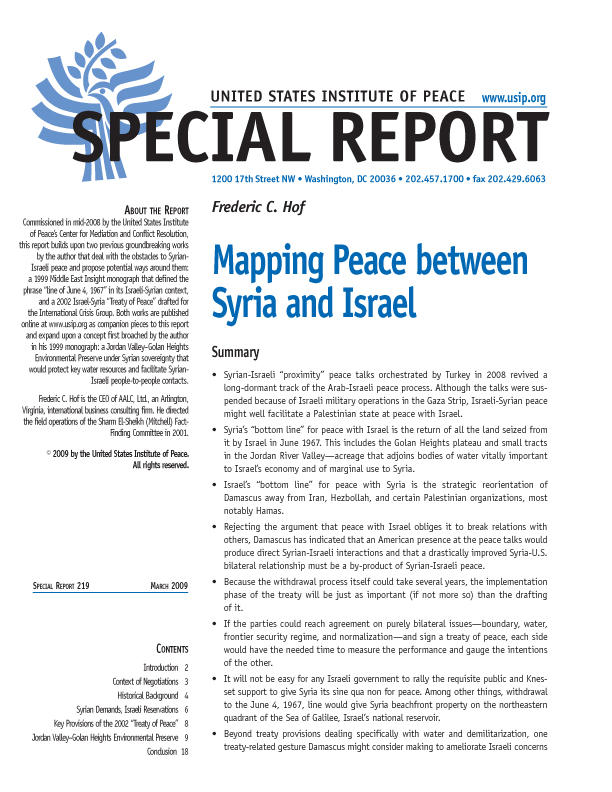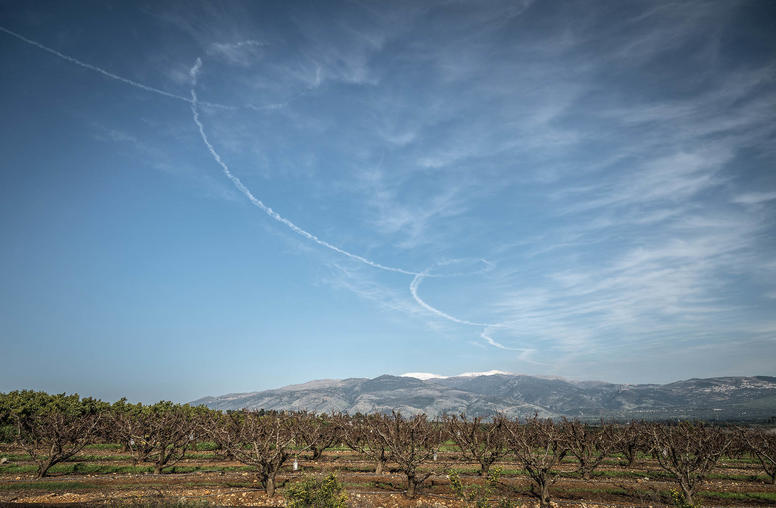Mapping Peace between Syria and Israel
Although the Palestinian-Israeli “track” of the Arab-Israeli dispute remains at the heart of the conflict between Israel and its neighbors, the very complexity of that track (Jerusalem, refugees, borders, etc.) has led some to consider the Israeli-Syrian track to be relatively simple and straightforward. While simple it is not and straightforward it is only in relative terms, the Syrian-Israeli conflict can indeed be settled without prejudice to the central act of the Arab-Israeli drama.

Summary
- Syrian-Israeli "proximity" peace talks orchestrated by Turkey in 2008 revived along-dormant track of the Arab-Israeli peace process. Although the talks were suspended because of Israeli military operations in the Gaza Strip, Israeli-Syrian peace might well facilitate a Palestinian state at peace with Israel.
- Syria's "bottom line" for peace with Israel is the return of all the land seized from it by Israel in June 1967. This includes the Golan Heights plateau and small tracts in the Jordan River Valley--acreage that adjoins bodies of water vitally important to Israel's economy and of marginal use to Syria.
- Israel's "bottom line" for peace with Syria is the strategic reorientation of Damascus away from Iran, Hezbollah, and certain Palestinian organizations, most notably Hamas.
- Rejecting the argument that peace with Israel obliges it to break relations with others, Damascus has indicated that an American presence at the peace talks would produce direct Syrian-Israeli interactions and that a drastically improved Syria-U.S. bilateral relationship must be a by-product of Syrian-Israeli peace.
- Because the withdrawal process itself could take several years, the implementation phase of the treaty will be just as important (if not more so) than the drafting of it.
- If the parties could reach agreement on purely bilateral issues--boundary, water, frontier security regime, and normalization--and sign a treaty of peace, each side would have the needed time to measure the performance and gauge the intentions of the other.
- It will not be easy for any Israeli government to rally the requisite public and Knesset support to give Syria its sine qua non for peace. Among other things, withdrawal to the June 4, 1967, line would give Syria beachfront property on the northeastern quadrant of the Sea of Galilee, Israel's national reservoir.
- Beyond treaty provisions dealing specifically with water and demilitarization, one treaty-related gesture Damascus might consider making to ameliorate Israeli concerns about a new boundary in the Jordan Valley would be to create a Jordan Valley–Golan Heights Environmental Preserve under Syrian sovereignty.
- Such a preserve could help to protect sensitive and stressed water resources in the valley and on the heights. It could also facilitate easy access by civilians from Israel to the full circumference of the Sea of Galilee and perhaps up into those parts of the Golan Heights covered by the preserve.
- While there are many approaches to the creation, size, purpose, and functioning of such a preserve, the one suggested in this report would be based on existing parks and reserves created by Israel during the occupation, which would be transferred to and administered by Syria.
- In addition to mitigating Israeli concerns about the return of sensitive territories and providing a venue for informal people-to-people contacts, the Jordan Valley–Golan Heights Environmental Preserve approach would give the parties a good platform for practical bilateral cooperation even as the ink on a peace treaty is drying, allowing for a constructive, confidence-building start to the implementation phase of the withdrawal process.
About the Report
Commissioned in mid-2008 by the United States Institute of Peace's Center for Mediation and Conflict Resolution, this report builds upon two previous groundbreaking works by the author that deal with the obstacles to Syrian-Israeli peace and propose potential ways around them: a 1999 Middle East Insight monograph that defined the phrase "line of June 4, 1967" in its Israeli-Syrian context, and a 2002 Israel-Syria "Treaty of Peace" drafted for the International Crisis Group. Both works are published online at www.usip.org as companion pieces to this report and expand upon a concept first broached by the author in his 1999 monograph: a Jordan Valley–Golan Heights Environmental Preserve under Syrian sovereignty that would protect key water resources and facilitate Syrian-Israeli people-to-people contacts.
Frederic C. Hof is the CEO of AALC, Ltd., an Arlington, Virginia, international business consulting firm. He directed the field operations of the Sharm El-Sheikh (Mitchell) Fact-Finding Committee in 2001.
Previous Works by the Author
- Line of Battle, Border of Peace - The Line of June 4, 1967
Middle East Insight Monograph, 1999 (PDF - 359 KB)
Originally printed in Middle East Insight, 1999.
Jonathan Kessler, Executive Editor - Middle East Endgame III: Israel, Syria and Lebanon -- How Comprehensive Peace Settlements Would Look
International Crisis Group Report, July 16, 2002
Related Works
- A Renewable Energy Peace Park in the Golan as a Framework to an Israeli-Syrian Agreement
USIP Peace Briefing by Yehuda Greenfield-Gilat, July 2009



